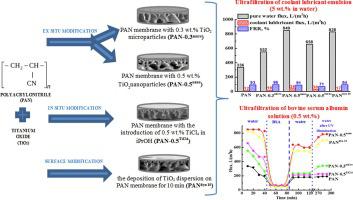Separation and Purification Technology ( IF 8.1 ) Pub Date : 2022-01-13 , DOI: 10.1016/j.seppur.2022.120500 Mariia Dmitrenko 1, 2 , Anna Kuzminova 1, 2 , Andrey Zolotarev 1, 2 , Denis Markelov 1, 2 , Andrei Komolkin 1 , Evgeniia Loginova 1 , Tatiana Plisko 3 , Katsiaryna Burts 3 , Alexandr Bildyukevich 3 , Anastasia Penkova 1, 2

|
The active application of ultrafiltration in various industries requires the development of novel membranes with tailored properties and good fouling resistance. This work is devoted to the improvement of ultrafiltration properties of polyacrylonitrile (PAN) membranes by various TiO2 modification approaches: (1) ex situ method - the introduction of pre-formed micro- or nanoparticles; (2) in situ method - the formation of TiO2 particles in the casting solution; and (3) surface modification method - dynamic deposition of TiO2 on the membrane surface. The effect of the various TiO2 immobilization techniques on the structure of PAN membranes was studied by scanning electron and atomic force microscopies, and the contact angle measurements. The introduction of TiO2 particles improved membrane performance and antifouling stability under UV irradiation in ultrafiltration of industrially important feeds - bovine serum albumin solution (BSA) and coolant lubricant emulsion. The affinity to water of TiO2-modified PAN membrane was confirmed by atomistic molecular dynamics simulations, swelling experiments, and calorimetric study of wetting. PAN membrane with 0.5 wt% TiO2 nanoparticles had the optimal transport characteristics and improved surface self-cleaning ability after UV irradiation: pure water, coolant lubricant, and BSA fluxes (849, 38, and 68 L/(m2h), respectively), and flux recovery ratio after UV-illumination (95%).
中文翻译:

聚丙烯腈超滤膜使用 TiO2 的改性策略以提高水处理中的防污性能
超滤在各个行业的积极应用需要开发具有定制性能和良好抗污染性的新型膜。这项工作致力于通过各种 TiO 2改性方法改善聚丙烯腈 (PAN) 膜的超滤性能:(1) 非原位方法 - 引入预先形成的微米或纳米粒子;(2)原位法——在浇注液中形成TiO 2颗粒;(3)表面改性法——在膜表面动态沉积TiO 2。不同TiO 2的影响通过扫描电子和原子力显微镜以及接触角测量研究了 PAN 膜结构的固定化技术。TiO 2颗粒的引入提高了工业上重要原料超滤(牛血清白蛋白溶液 (BSA) 和冷却润滑剂乳液)在紫外线照射下的膜性能和防污稳定性。通过原子分子动力学模拟、溶胀实验和润湿量热研究证实了TiO 2改性 PAN 膜对水的亲和力。含有 0.5 wt% TiO 2的 PAN 膜纳米粒子在紫外线照射后具有最佳的传输特性和提高的表面自清洁能力:纯水、冷却润滑剂和 BSA 通量(分别为 849、38 和 68 L/(m 2 h)),以及紫外线后的通量恢复率-照明(95%)。











































 京公网安备 11010802027423号
京公网安备 11010802027423号